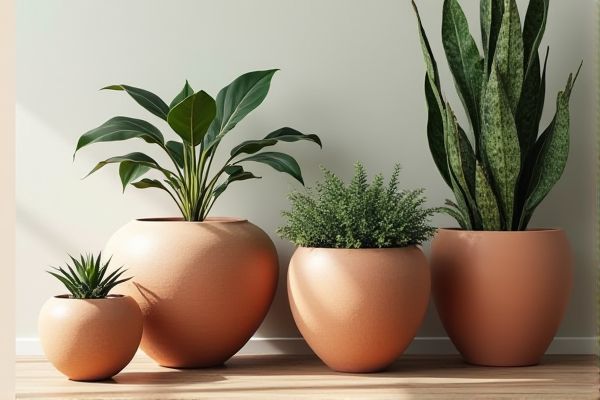
Ceramic planters offer a wide range of colors and glazed finishes that retain moisture well, making them ideal for plants needing consistent hydration, while terracotta planters provide natural breathability and excellent drainage but tend to dry out faster. Discover how choosing the right planter can enhance Your plant's health by exploring the detailed comparison in the rest of this article.
Table of Comparison
| Feature | Ceramic Planter | Terracotta Planter |
|---|---|---|
| Material | Glazed or unglazed fired clay | Unglazed porous clay |
| Porosity | Low porosity (glazed); retains moisture | High porosity; allows air and water flow |
| Water Retention | Better water retention due to glaze | Dries out faster; good drainage |
| Weight | Heavier, especially glazed | Lighter compared to glazed ceramic |
| Durability | More durable and chip-resistant | Prone to cracking and chipping |
| Aesthetic | Variety of colors and finishes | Natural earthy reddish-brown |
| Cost | Generally more expensive | Usually more affordable |
| Best Use | Indoor plants, decorative use, moisture-loving plants | Outdoor plants, drought-tolerant plants, plants needing airflow |
Introduction to Ceramic and Terracotta Planters
Ceramic planters are crafted from glazed clay that offers a smooth, non-porous surface ideal for moisture retention and aesthetic variety, often available in vibrant colors and intricate designs. Terracotta planters, made from unglazed natural clay, provide porous walls that promote air circulation and drainage, making them suitable for plants requiring well-aerated soil conditions. Both planter types differ in material properties and benefits, influencing plant health and decorative style choices in indoor and outdoor gardening.
Material Composition: Ceramic vs Terracotta
Ceramic planters are made from clay that is fired at high temperatures and often glazed, providing a smooth, decorative finish that resists water absorption. Terracotta planters consist of natural, porous clay that is unglazed, allowing for better airflow and moisture regulation to plant roots. Your choice depends on whether you prioritize the durability and sleek look of ceramic or the natural breathability and traditional aesthetic offered by terracotta.
Aesthetic Appeal and Design Variations
Ceramic planters offer a sleek, glossy finish with a wide range of colors and intricate patterns that enhance modern and contemporary spaces, while terracotta planters boast a warm, earthy tone and rustic texture ideal for traditional or Mediterranean styles. You can choose ceramic for bold, vibrant designs or terracotta for natural, weathered aesthetics, each adding distinct character to your garden or indoor plant display. Both materials provide versatile options to complement different decor themes, balancing visual appeal with functional plant care.
Durability and Longevity Comparison
Ceramic planters typically offer greater durability and resistance to chipping compared to terracotta, which is more porous and prone to cracking under harsh weather conditions. Terracotta planters excel in breathability, allowing better air and moisture exchange for plant roots, but they generally require more careful handling and seasonal protection to prolong their lifespan. Choosing a ceramic planter can enhance your garden's longevity with low maintenance while terracotta demands regular care to maintain its structural integrity.
Water Retention and Breathability
Ceramic planters offer superior water retention due to their glazed surfaces, which reduce moisture evaporation and keep soil consistently damp for plants that require steady hydration. Terracotta planters provide excellent breathability, allowing air and water to pass through their porous walls, which helps prevent root rot and promotes healthier root systems. Your choice depends on the specific water and airflow needs of your plants; use ceramic for moisture-loving species and terracotta for those needing well-drained soil.
Weight and Portability Factors
Ceramic planters are generally heavier than terracotta planters due to their denser material and often glazed finish, making them less portable for frequent relocation. Terracotta planters are lighter and more porous, enhancing ease of movement while still providing breathability for plant roots. Weight differences impact usability in balconies or indoor settings where mobility is crucial.
Suitability for Indoor and Outdoor Use
Ceramic planters offer excellent moisture retention and come in a variety of glazed finishes, making them highly suitable for indoor use where controlled humidity is essential. Terracotta planters, known for their porous nature, provide superior aeration and drainage, making them ideal for outdoor settings where excess water needs to evaporate quickly. When choosing between the two, consider your plant's watering needs and whether your planter will be exposed to outdoor elements or kept indoors to ensure optimal growth.
Maintenance and Cleaning Requirements
Ceramic planters require minimal maintenance with smooth, non-porous surfaces that resist stains and retain moisture, reducing the frequency of watering. Terracotta planters are porous, which means they absorb water and salts, leading to potential cracking and requiring regular cleaning and sealing to maintain durability. Your choice depends on how much time you can dedicate to upkeep, with ceramic planters offering a low-maintenance option compared to the more demanding care terracotta planters need.
Pricing and Cost Effectiveness
Ceramic planters typically cost more than terracotta planters due to their glazed finishes and intricate designs that increase production expenses. Terracotta planters offer cost effectiveness with their affordable price and natural porous properties that promote healthy plant growth without additional coatings. You can save money by choosing terracotta when budget is a priority, while ceramic planters provide aesthetic value that may justify the higher investment.
Choosing the Right Planter for Your Plants
Ceramic planters offer excellent moisture retention and come in various glazed finishes that protect roots from temperature fluctuations, making them ideal for delicate indoor plants. Terracotta planters are porous, allowing better air circulation and drainage, which prevents root rot in drought-tolerant or Mediterranean plants. Your choice should depend on your plant's watering needs and environmental tolerance to optimize growth and health.
 homyna.com
homyna.com